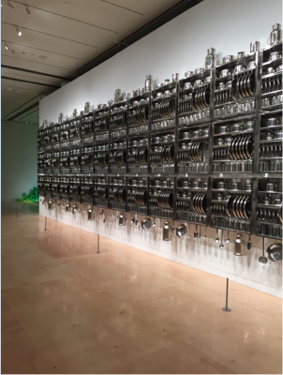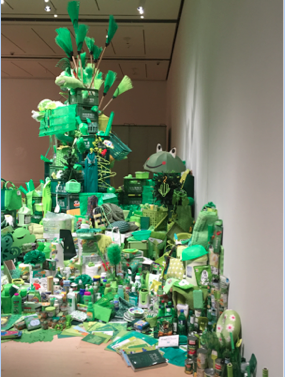Megacities Asia

Megacities Asia
Museum of Fine Arts, Boston
April 3, 2016 – July 17, 2016
The Museum of Fine Arts, Boston’s (MFA) summer 2016 exhibition Megacities Asia invited visitors to visually immerse themselves in the frenetic pulse of five global megacities from the world’s most populous continent. A “megacity” is defined as a city whose population reaches or exceeds 10 million inhabitants. [1] Curators Laura Weinstein and Al Miner offered a vibrant sensory experience of life and artistic production from five megacities: Seoul, Mumbai, New Delhi, Shanghai and Beijing. The artists included in the exhibition draw on a diversity of materials, forms, and colors to create sculptures that play on the tensions between towering size and minute details. Despite this visual range, the exhibition organized its works into four neat thematic categories that spoke to broader issues in megacities: consumption and consumerism, modes of transportation, living spaces, and changing landscapes.
Walking into the capacious Ann and Graham Gund Gallery, the eye was unable to focus due to the complexly detailed nature of each sculpture. Common among all of the works in the exhibition was the artists’ use of large accumulations of everyday objects that were assembled on a grand scale. New Delhi artist Subodh Gupta’s, Take off your shoes and wash your hands (2008), presented a wall—stacked nearly floor to ceiling—with uniform stainless steel kitchenware. When viewers approached the glimmering pots, pans and utensils, their reflections were distorted as if standing before a fun house mirror. Warping the viewer’s body and likeness, Gupta’s piece elaborated the curatorial desire to show that life in a megacity can be dizzying due to the large populations and fast paced quality of life. However, this work proved that despite the obviously chaotic nature of large global cities, there is still space for reflection and individuality. The title of the work offers viewers a sense that they are being invited into a home, perhaps, or a sacred space, and are about to partake in a comforting meal in the presence of family and friends.

While the majority of the exhibition was installed in the Gund Gallery, several affiliate works were placed throughout the MFA in galleries, courtyards, and on the museum’s front lawn. Choi Jeong Hwa’s, Breathing Flower (2016), greeted visitors outside of the Museum’s Huntington Avenue entrance, where the inflatable sculpture of a red lotus would inflate and sway delicately on a regulated loop. Ai Weiwei’s, Forever (2003), was installed in the Ruth and Carl J. Shapiro courtyard creating a bold metallic contrast to the towering Dale Chihuly sculpture that resides in the courtyard as part of the Museum’s permanent collection. The concept behind this curatorial choice was to encourage visitors to engage with the Museum at large and to further emphasize the sprawling feel of the Asian cities incorporated in this exhibition; however, the ultimate effect of seeing the installations outside of the main exhibition hall did not foster an enhanced, interactive visitor experience. Such was the case with another work by Choi Jeong Hwa, titled Alchemy (2016), a series’ of stacked brightly colored plastic imitations of traditional glass objects. The piece was positioned alternatingly between the ionic columns of a staircase leading from the museum’s rotunda to the second floor galleries. Posing a stark contrast to the mathematically precise neoclassical MFA architecture, Alchemy was likely installed in this space to spark dialogues surrounding the historically separate traditions of Western and Nonwestern art history, but instead may have created a sense of confusion for visitors wondering why they were seeing works of contemporary art in historical galleries. Despite this missed connection, the overall exhibition presented an engaging experience that not only offered insight into the state of contemporary art in Asia, but also the way that Asian artists have chosen to render and make sense of the dynamic cities they call home.

Hannah Braun
[1] Cambridge English Dictionary OnLine, s.v. “megacity,” accessed October 14, 2016, http://dictionary.cambridge.org/us/dictionary/english/megacity.